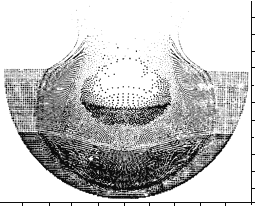 |
Science Frontiers ONLINE No. 63: May-Jun 1989 |
|
|
Comets And Life
 A comet impact: Cross-sectional view 0.637s after impact of a comet into a 3km-deep ocean (light dots) underlain by basaltic crust (darker grid) in the smoothed particle hydrodynamic model of Thomas et al. Small vertical ticks are 1 km apart, small horizontal ticks 1.25 km apart. The comet in this figure has a radius of 1 kilometer and an impact velocity of 15 km/s and is shown by dark dots in the ocean. The initial spherical comet has become flattened, and parts of it have separated from the main body. The back side of the comet and most of the separated particles are much lower in temperature than the impacting side, and in an impact of a smaller comet (which would look much the same), organic material at the rear of the comet would survive intact. Figure provided by Paul Thomas. |
"New simulations suggest that large amounts of the organic molecules needed to form the first life on Earth could have been brought by comets that bombarded the planet early in its history. The models show that comets of moderate size would have slowed down enough during entry into the Earth's atmosphere for their organic component to survive the impact intact...... "The idea that comets supplied the Earth with the organic material needed to create life has been around for more than 20 years, but as often as some scientists have put forth the hypothesis, others have shot it down.
"About 20% of comet nuclei are composed of organic matter, the rest ice and dust. Most of the organic component appears to be in a complex, polymerized form similar to kerogen, which is found in sedimentary rocks on Earth. From 4.33.7 billion years ago, during the period of heaviest bombardment by meteorites and comets, an estimated 1023 g of organic material would have been added to Earth by comet impacts had they made up 10% of the extraterrestrial flux. That is 1001000 times larger than most estimates of the photochemical production of the compounds over the same period."
(Anonymous; "Comets and Life," Eos, no. 13, 1989.)
Comment. Nowhere in the above article does one find the name of Fred Hoyle, whose ideas along these lines have been ridiculed for years.